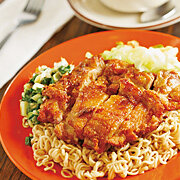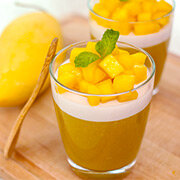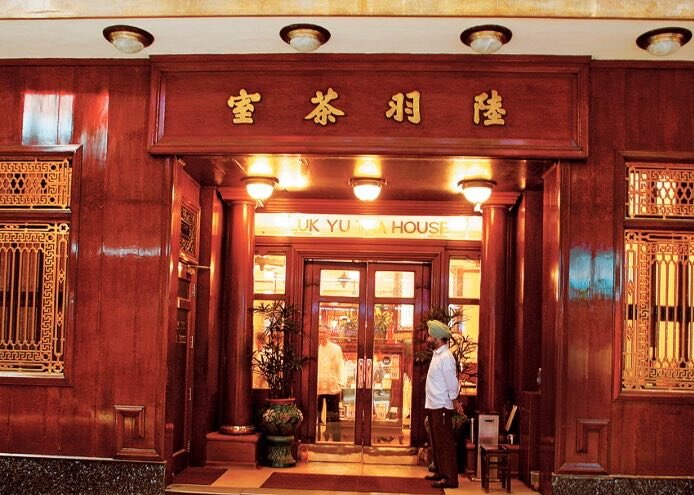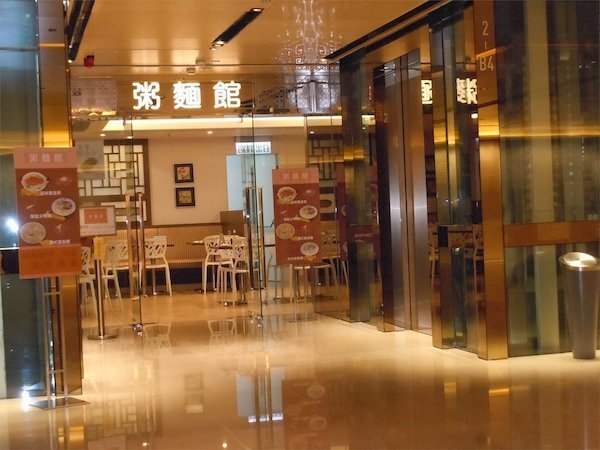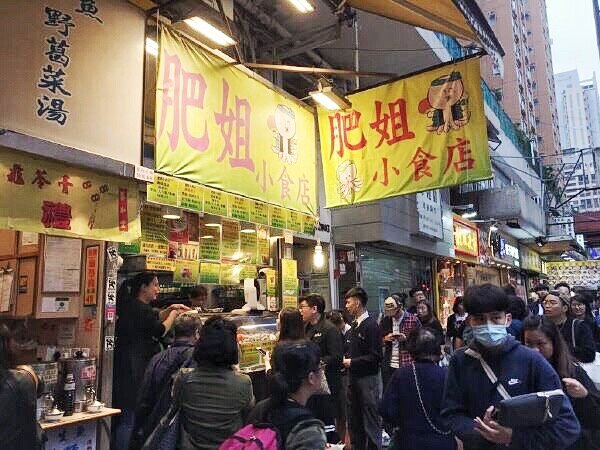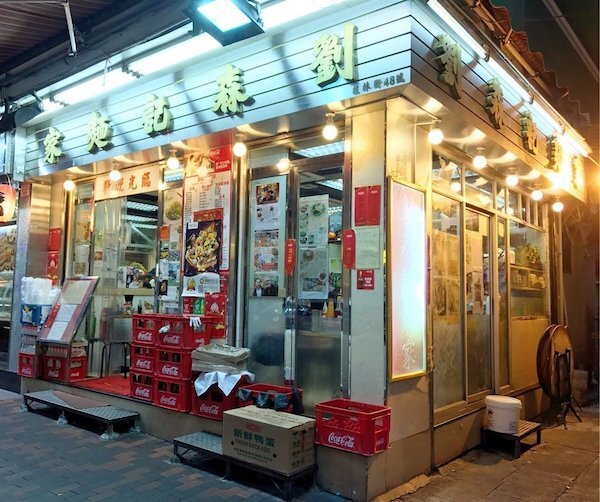HONG KONG FOOD GUIDE
Hong Kong’s reputation as a food lover’s paradise is not without good reason. With over 200 Michelin rated restaurants from pocket friendly street food eats to high end fine dining there is something to satisfy everyones wallet and taste buds.
If you would like to eat like a local in Hong Kong be sure to wrap your tastebuds around as many of the items listed in our local flavours guide as you can. Wondering where to eat? Check out the local restaurants section for our top picks, many of which are Michelin rated. And finally, take a taste of Hong Kong back home with our recipes.
LOCAL FLAVOURS
Lou Ding is a dish that is fast, convenient and tasty meal that is strongly associated with the city.
If you don’t like to be limited by a menu, cart noodles are the best choice for you as you can mix and match the ingredients. This started as a street hawker meal in the 1950s.
Stir-fried noodles with beef is one of the most common renditions of noodles in this style.
Traditionally, bite-sized wontons (a kind of Chinese dumpling) are served in an aromatic stock with noodles that are springy to the bite.
Rice noodles are often served in soup with beef balls or fish balls. Cantonese meat and fish balls differ from their Western counterparts in texture.
Chiu Chow congee is made tender and fragrant by covering it and letting it stand for about half an hour after it is cooked.
Congee, or rice porridge, is found all over China. However, it is unlikely that anyone puts more effort into congee than the Cantonese.
Hong Kong has taken durian — an import from Southeast Asia — and worked it into a myriad of combinations, including durian ice-cream, durian sorbet and durian slush drinks.
Mostly made using agar, fresh mangoes, evaporated milk and sugar, mango pudding is a mainstay of Hong Kong dessert menus.
This is a popular winter treat. The ingredients are placed in a bowl which is then immersed in water in a larger container and stewed for several hours.
A kind of sweet rice dumpling, tongyuen are often eaten at family gatherings during festivals as the name sounds like ‘family reunion’.
Made with a soft tofu, this pudding is traditionally served with sweet ginger or clear syrup.
This is a typical traditional Chinese dessert, many of which can be eaten like a soup. It is pleasantly sweet and relatively light. It can be served cold or hot, depending on the season.
Although they’re called the ‘three treasures’, there are actually more than three varieties. Freshly minced dace is stuffed into sliced eggplants, green peppers, tofu puffs, smoked red sausage or mushrooms, and then grilled on a griddle.
Slow-cooked beef smooth tripe, small intestines, large intestines, honeycomb tripe, lungs and more are served with chu hou sauce and refreshingly sweet turnip
Chunks of crispy, fermented tofu that have been deep-fried before being slathered with your choice of sauce (usually chilli or hoisin), this is one of the city’s most popular street stall foods.
Almost every Hongkonger has a favourite fish ball vendor. Bouncy and fluffy, the best Hong Kong-style fish balls are made with freshly ground fish paste, hand-beaten and slammed to springy perfection.
Originating in Shunde, Guangdong province, this traditional pastry is made by steaming a dough mixture of rice flour, white sugar, water and yeast.
Often translated as ‘sticky rice pudding’, put chai ko is typically made of rice flour and red beans. These ingredients are put in a small china bowl.
Sweetened egg batter grilled in a mould to make puffs. Crunchy on the outside, soft on the inside.
A pastry-crust filled with egg custard and baked. This popular Hong Kong snack probably originates from English custard cakes.
Legend has it that when the winter-melon puffs made by a woman in Guangdong province were highly praised in public, her husband proudly declared that they were his wife’s cakes. The name ‘wife cake’ stuck.
Traditionally, pineapple bun contained no pineapple and earned its name because its chequered top resembles the skin of a pineapple. The top half of the bun is made from cookie-type dough, while the bottom is made from Chinese-style bread dough, which tends to be softer and sweeter than Western bread.
Dim sum means ‘touch your heart’ and with as many as 150 items on a restaurant menu, and 2,000 in the entire range, it is a challenge to not find something you love. As Cantonese people tend to avoid fried foods early in the day, steamed dishes dominate most dim sum menus.
It is impossible to miss this cuisine in Hong Kong because after the highly seasoned meats are roasted on spits over an open fire or in a rotisserie oven, they are hung inside the restaurant and visible from the street. You’ll see siu mei hanging in fast-food chains, high-end restaurants and supermarkets.
LOCAL RESTAURANTS
As a compact city with more than 14,000 restaurants, Hong Kong could be described as a dining district in itself. Where to go? Culinary discoveries can be made just about anywhere in the city. Check out these top picks from the Hello! Hong Kong Tours team for guaranteed satisfaction.
If you would like a guided food exploration book onto one of food tours. Our Hong Kong Island Food Tour will give you a solid introduction to what Hong Kong food is. It is the winner of the tripadvisor Travelers’ Choice Award and covers the very best of Hong Kong’s food; Dim Sum, Wonton Noodles, Char Siu (BBQ Pork), Egg Tarts and Milk Tea.
Our Kowloon Street Food and Culture Tours visit several of the Michelin rated street food eateries listed below.
If you book a Private Customised Tour we can take you to any of the local restaurants that you like.
Po Kee is familiar to anyone who’s lived in Western District as it’s been a feature here for over 40 years and for many local residents a bowl of rice noodles (Lai Fan) with roasted duck leg remains a cherished childhood memory.
This family-run shop has been feeding hungry locals with Cantonese noodle soup since 1994. It prides itself on its signature beef brisket – braised one night ahead and steeped in a spiced marinade overnight for silky tenderness and deep flavours.
Its gigantic red sign, typical greasy spoon style interior and traditional stir-fries all point to an authentic Hong Kong culinary experience. Claypot rice is only served at night and features a three-rice blend enrobed in the oil brushed on the bottom of the pot.
This huge two-floor eatery opened in 2009 with the aim of building on the success of the famous Lin Heung Tea House in Wellington Street. It's modest inside but hugely popular and the dim sum trolley is a must, with customers keen to be the first to choose from its extensive offerings.
One of the oldest Chiu Chow restaurants in Hong Kong, Chan Kan Kee features omelettes, deep fried duck and steamed sliced eel. Li Ka Shing is said to order takeout from this place.
Located next to Sheung Wan market, this traditionally styled, simple but well maintained barbecue shop has been run by the same family since the mid-1970s. Over the years they’ve built up an appreciative following so the small place fills quickly.
With over 90 years of history in Hong Kong, Kau Kee Restaurant is famous of their Beef Brisket Noodles served in clear broth and Beef Curry Noodles. This restaurant almost always has a long line so try to visit during non peak hours.
This highly regarded, simple noodle shop has been here since 1998 and is easy to spot – just look for the lunchtime queues. The staff are as bright as their aprons; the popular side booths are quickly snapped up; and the regulars know to eat outside peak times when the pace is less frenetic.
Wang Fu was one of the first shops to open on Wellington Street and its Pekingese dumplings are renowned. It is a Beijing-style restaurant that is famous for their traditional handmade dumplings.
Large numbers of both regulars and tourists come to Luk Yu Tea House for the traditionally prepared and flavoursome dim sum, and its three floors fill up quickly. The animated atmosphere and subtle colonial decoration are appealing but no one really stays too long; the serving team in white jackets have seen it all before and go about their work with alacrity.
The signature roast geese glistening behind the window are marinated with a secret recipe and go through over 20 preparatory steps before being chargrilled to perfection. Char siu pork uses pork shoulder from Brazil for melty tenderness.
Having stood here proudly for over 40 years, Sang Kee is a true symbol of Wan Chai and remains refreshingly impervious to modernisation. The owner insists on buying the seafood herself each day and the Cantonese dishes are prepared using traditional methods.
The Kam family name is synonymous with their famous roast goose restaurant. This Guangdong-style restaurant is owned by the third generation of the family and he wisely hired his father’s former chef to ensure the goose is as crisp and succulent as ever.
No discussion about Hong Kong’s historic noodle shops would be complete without mentioning Ho Hung Kee, an authentic Hong Kong-style congee and noodle shop, which originally opened in Wan Chai in the 1940s and is famed for its springy wonton noodles and fresh, sweet soup.
Egg puffs made to order, in over 10 classic or innovative flavours, such sweet potato, chestnut and macha red bean. Prepare to queue.
This shop is operated by the son of the famous “Fei Jie” , owner of the popular local snack joint in Mong Kok. Their braised skewers are flavourful, which cuttlefish, pork liver, turkey gizzard, and pork intestine are recommended.
No one is here for the no-frills interior, typical of any noodle shop in Hong Kong. This 60-year-old establishment is all about Cantonese wonton soup noodles – firm and bouncy prawns, visible through the paper-thin translucent skin, with springy duck egg noodles swimming in a flavourful broth.
Traditional dessert recommended by the Michelin Guide for two years. The taste of the handmade dessert is awesome.
Aimed at reimagining and redefining Cantonese cuisine, the spirit of innovation is at the heart of the restaurant's success. Bold, rich flavours weave through the modern art of fine dining at Ming Court.
In business for over 20 years, this shop is famous for its snake soup. While most people consume snake soup only in winter, the owner formulates a different herbal base for every season to make it a healthy tonic all year round.
The shop has a traditional feel to it after renovation. Green wooden window frames on the wall are reminiscent of old-time Hong Kong. Dumplings are handmade daily and only the freshest ingredients are used in the fillings.
One of the rare Jook Sing Noodle shop, visitors can still see the cooking procedure of the bamboo stick noodles, this special recipe noodle has a spongy texture and you can request takeaway if you don’t want to wait.
The multinational group began life here in the 1970s with this, their original shop; it’s still as busy as ever and worth booking ahead. The restaurant is spread over two floors with the upper floor boasting a large live fish tank and views of the busy street below.
This Chinese bakery started as a hawker long ago and operated till now. Its specialties include homemade white sugar pudding, clay-pot pudding, red bean pudding, sesame pudding and fluffy cake.
One of the most popular snack shops in Hong Kong, it specialises in tofu snacks, especially the "Tofu Fa"- its most celebrated dish. This little snack shop is very affordable and good for a healthy snack.
Tim Ho Wan is a dim sum restaurant with one Michelin star where every dish is steamed upon order. The second branch of this famous dim sum chain is roomier than the original, but don’t be surprised to still find a queue of expectant diners at the entrance.
Hidden in a glass office tower, this simple shop may have no ambiance or character to speak of, but guests come for the creamy congee made by a chef with over 30 years of experience. Bestsellers include fresh crab congee and salted pork ribs congee with bitter melon.
It is said that they sell about 5,000 steamed rice rolls per day. The steamed rice roll is silky, smooth and flavoursome, seasoned with peanut sauce and lard.
Customers here are spoilt for choice with Hong Kong-style snacks, ranging from innards and cuttlefish to mini waffles. Not only does the food attract customers but the price is also a key factor.
The speedy-paced Australia Dairy Company offers high-quality fried egg, with a smooth and juicy texture and a surprisingly strong flavor.
A classic dai pai dong, Sing Heung Yuen is famous for their macaroni, instant noodles and crispy buttered buns. Drop by either for a quick snack or a full meal.
Yum Cha serves traditional Chinese dishes and dim sum with a modern twist. The food is infused with a hint of playfulness, while maintaining authentic flavors and the original essence of each dish.
One of the most representative restaurants in Sham Shui Po District, Wai Kee’s iconic Pork Liver and Beef Noodle will never let you down. Its pig’s liver noodles, might not sound the most appealing, but locals and tourists alike make the journey to Sham Shui Po for this unique dish.
Man Kee Cart Noodles is so popular that it boasts three outlets on the same block – all of which are constantly packed with diners. The eatery offers a diverse selection of noodle types, soup bases and ingredients that are all prepared fresh to order.
One of the 'Sham Shui Po Best 3', Lau Sam Kee must-try dishes include Shrimp Roe and Beef Stomach, and the Pickled Radish on the table is an unforgettable side dish.
RECIPES
No doubt you will discover some foodie delights, in Hong Kong, that you simply can not live without. Fear not! Follow our local flavour recipes to bring a taste of Hong Kong back home.
One of the MUST-EAT food, when you are in a Hello! Hong Kong tour is the Hong Kong-Style french toast called Sai Do Si.
A popular Chinese dish commonly served as a dessert in Hong Kong. A must-try local food on your Hello! Hong Kong tour.
Har Gow is a traditional Cantonese dumpling served in dim sum. A must try on your Hello! Hong Kong tours.
All-time childhood food favorite and long-standing popular street food in Hong Kong.
A favorite snack of locals and tourists alike because if its sweetness and a representation of the colonial history of Hong Kong.
A rice noodle roll is a Cantonese dish commonly served either as a snack, small meal or as a variety of dim sum. In Hong Kong
Char Siu is a popular way to flavor barbecued pork in Cantonese cuisine that you can try when you are on a Hello! Hong Kong tours
A tea drink made from black tea and evaporated milk that you can drink hot or cold at any time of the day!

